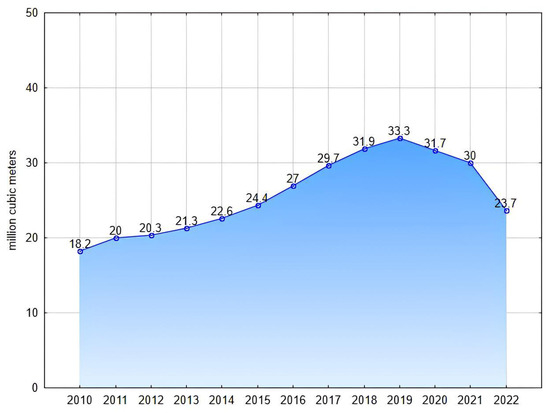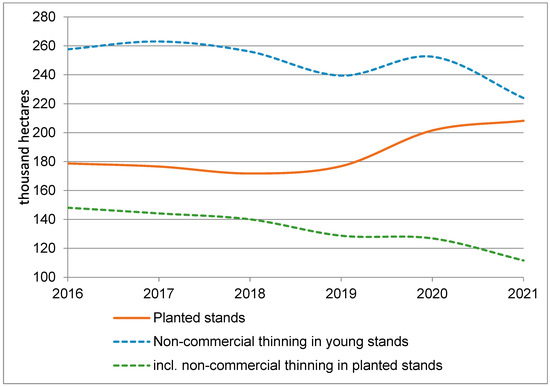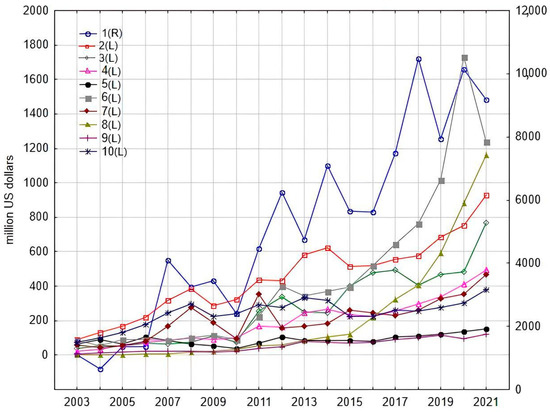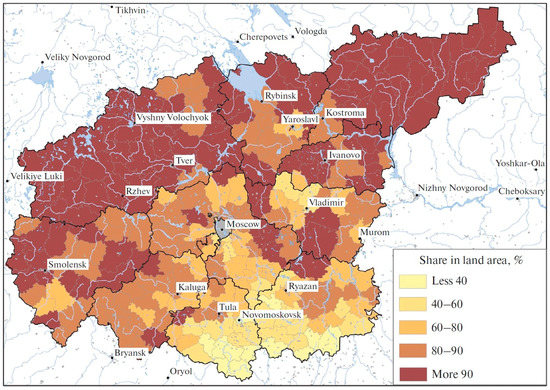The further development of the sector, however, could be seriously undermined by the depletion of forest resources available under the current timber extractive model of forest management in Russia, also known as “an extensive forest management model”. In this model, after harvesting all old forests in one place, the frontier of clearcuts moves further to the mature primary intact coniferous forests. Clearcut areas are mainly left for natural regeneration, while human-made forest regeneration is sporadic and non-effective. The current model of timber extraction in the country is quite archaic and bears serious risks to the future development of the forest industries if not reformed. The current forest policy prioritizes the development of new areas (timber extraction) over enhancing the forest productivity of already developed areas using silvicultural methods. The policy is grounded on a misbelief that there are enough mature productive coniferous forests in Russia to ensure continuous timber production in long run—even at a much higher level than now.
2. How to Promote the Introduction of the Intensive Forestry Management Model in Russia?
Today, planted forests constitute only one-fifth of the total forest regeneration area in Russia. This means that most clearcut areas, even those lacking a sufficient potential for natural regeneration of commercially valuable tree species, are still left for natural regeneration. In many cases, restoration of coniferous forests takes more than a hundred of years and/or is featured by continuous domination of early successional broadleaved tree species, like birch and aspen. This means that it is necessary to radically revise the requirements for all types of felling, considering all increasing possibilities for the utilization of low-quality timber, including that resulting from thinning operations.
Formally, the area of artificial regeneration in Russia has grown in recent years (
Figure 3). However, its quality suffers due to poor tending (both agrotechnical and silvicultural) in planted forests. Timely thinning in young stands is critical for the formation of productive coniferous stands. In reality, the total area of non-commercial thinning in young forests decreases and is now equal to the area of artificial regeneration. Moreover, according to the official statistics, only half of all planted forests are thinned. A comparison of the thinning and regeneration area in Russia and Belarus, which initially had a similar forest management system, shows that the ratio between the thinning and regeneration areas in Belarus is 3.9–5.4 times bigger than in Russia [
27]. The experience of Sweden and Finland in forestry (
Table 2) shows that the area of non-commercial thinning shall be 2–3 times greater than the area of planted forests and/or plantations, since thinning must be repeated several times in the same area to achieve a significant silvicultural effect. A serious problem is the quality of thinning in young forests. To reduce the cost of the forest management plan implementation, concession holders often prefer to perform thinning just along the rows of planted trees (so-called corridor thinning) rather than thinning throughout the whole stand. Corridor thinning mainly produces only an insignificant and very short-lived silvicultural effect because coniferous trees soon become outcompeted by fast-growing early successional broadleaf trees (mainly birch and aspen) growing along the corridor borders. In addition, coniferous trees in rows could be planted too close to each other.
Figure 3. Dynamics of areas of artificial regeneration and thinned young forests. Source: Bulletins on Environmental Protection (Byulleteni ob okhrane okruzhayushchey sredy) (electronic versions). Information on Reforestation and Afforestation for 2016–2021 (Svedeniya o vosproizvodstve lesov i lesprazvedenii za 2016–2021) (Electronic resource),
https://rosstat.gov.ru/compendium/document/13295 (accessed on 15 October 2022).
The potential area where the IURF model could be introduced in the coming years in Russia will still be several times less than the area under the conventional extensive forest management model. Therefore, regeneration of clearcuts will still predominantly occur through natural regeneration, in the absence of silvicultural activities. As a result, forest regeneration will be entirely driven by natural ecological succession patterns specific to habitat types. Therefore, the forest authorities (and responsible forest industries that plan to carry out forest management on forest concession areas not only in the next 5–10 years, but in the long term) shall be interested in the replacement of conventional clearcuts with retention forestry. For example, this may imply retention of forested patches or individual trees when making large-sized clearcuts to provide habitat diversity and to protect scenic, conservation and other values, for at least one rotation [
51]. The maintenance of the mosaic forest cover and preservation of viable coniferous undergrowth and seeding sources and ecologically valuables habitats (retention trees and patches [
52]) are far better methods to provide better renewal conditions for coniferous species, although at the cost of reducing the total harvest on the plot by 5%–15%.
When assessing the quality of works on artificial regeneration, the focus should be shifted from the area of planted forests to the assessment of the result at a stage when young stands reach the pole-size, i.e., to assess the work on the actually obtained areas of economically valuable young forests.
The current volume of works on thinning of planted forests (and in areas with high natural regeneration) is absolutely insufficient. Non-commercial thinning treatments in young stands that did not pass the sapling stage (or precommercial thinning, as it is called in Finland and Sweden) are the key silvicultural operations to gaining a long-term silvicultural effect. In the future, their area shall be increased by several (4–6) times [
27]. We think that to ensure a sustainable forest supply, the government should aim to manage at least 30–50 million hectares according to IURF by the years 2030. Therefore, it is better to concentrate available resources on the most promising areas of planted forests to deliver silvicultural measures in time and in full than to thinly distribute them throughout a larger area but without a sound silvicultural effect. Obviously, so called “corridor thinning” in young forests in most cases does not yield a significant silvicultural effect. It is still used, though, because it is much cheaper than perform thinning of the whole area, it does not require qualified personnel, and it permits the reporting of a greater area of performed works to the authorities in charge.
The authors think that both extensive and intensive management models could successfully coexist even within the same forest logging concession. Only 75.8% of the total area of forest concessions, that is, 25.4% of all forests of the Forest Land Category—Goslesfond forests [
22] actually suit for forestry purposes. In addition, in the future, potential private forests on abandoned agricultural lands also could be used for forestry purposes. The remaining 74.6% of forest on Goslesfond lands can be still primarily used for other purposes than timber harvesting (environmental, climatic, recreational, conservation, etc.).
At the same time, it is necessary to introduce economic incentives for the intensive use and reproduction of forests (IURF), considering changes in the market demand:
Economic mechanisms should stimulate forest management in secondary and previously developed forests located in southern areas with better climatic conditions a higher road density, rather than to maintain an extensive forest management model aimed at the development of remote forests in areas that lack roads and are characterized by low natural productivity.
To move away from charging forest fees based on “allowable annual cut” (AAC) as a non-economically sound tool (set up by the Federal Forestry Agency) for a payment for a leased forest area (forest concession), which is controlled by federal executive authorities independent from the Federal Forestry Agency (like the Federal Agency for State Property Management—Rosimushchestvo—and the Federal Services for State Registration, Cadaster and Cartography—Roskadastr). It should encourage leaseholders to intensify afforestation, including thinning, a conscious choice of seedlings, seeds, etc. In this case, everything that has grown due to the leaseholders’ investments will go to their profit and will not increase rent payments.
To switch to diameter-based felling instead of age-based felling. As a result, this will stimulate transition from “process”-based financing of forestry activities to achieving the planned results. One may expect that this would make it possible to decrease the minimum felling age of forest stands without compromising environmental damage.
According to the market demand, all types of forests in forest concessions require thinning operations, including deciduous forests dominated by early successional tree species (for example, to increase the yield of plywood birch logs and to reduce a share of low-grade birch assortments and others).
Information on forest resources should be publicly available to attract investments and investors to the forestry sector of the economy. The information of the remote satellite monitoring system (ISDM-Rosleskhoz) from the very beginning is based on data from various satellite systems [
53,
54], and most of the information is based on data from foreign satellites. As a result, the basic information on the characteristics and stocks of wood in the forests of Russia has been known for a long time. Therefore, attempts to hide it by the forest management authorities only reflect their desire to avoid being controlled, both by the society and the government. Forest declarations (a document containing stand-level information on planned harvesting operations, including production volumes and maps that concession holders should annually submit to regional forest authorities) should also be posted on the Internet [
30].
3. Challenge of “Spatial de-Marginalization” of the Russian Forestry Complex
It is obvious that a transition to the IURF model is more beneficial in the regions with a higher natural productivity of forests, a denser network of forest roads, and a developed wood-processing infrastructure. The task of the demarginalization of the Russian forest industries within the forested part of the country is quite an urgent task that includes a shift in main harvesting activities and respective processing infrastructure from low-productivity northern taiga forests of ER and from “greenfield” projects in wilderness forest areas currently lacking any kind of infrastructure in Central and Eastern Siberia to more productive secondary mixed and broadleaf forests (currently dominated by early successional broadleaf species) in southern areas with better climatic conditions with a relatively dense network of roads (67 km per 1000 ha and above). This statement is confirmed by the increasing foreign investments before 2022 in wood processing and production of wood-based panels, sheet materials, etc., by companies like Kronospan (processing facilities in the Republic of Bashkortostan, Moscow and Kaluga regions—a priority investment project in the field of forest development for 2016–2025 was registered in the latter), Egger (processing facilities in Smolensk and Ivanovo regions) and KASTAMONU (processing facility in Elabuga, Republic of Tatarstan) and by an increasing number of birch plywood producers (i.e., Nizhny Novgorod region), etc. These projects and facts seem to be more significant (see
Table 1) than the “universal” disappointment with the lack of invested billions of dollars and Euros into the construction of new traditional pulp and paper mills, especially given the decline in demand on newsprint and graphic paper grades because of digitalization and growing demand mainly only for packaging materials and products. The regions mentioned above lost their large primary forests a long time ago. They do remain, however, in the specially protected natural areas of the federal level, some of which are even sparsely forested (the forest area of the Republic of Tatarstan occupies 17.5% of the region), but it is obviously compensated for by a significantly greater productivity of the southern belt forests than of the northern taiga [
55,
56].
At the same time, vertically integrated forest industry companies mainly think in terms of wood supply for already existing industries like sawmills, pulp and paper mills and of the remote and roadless “greenfields” development that requires much more investments than just in building a new pulp and paper mill itself (estimated at USD 2.2 billion). As a result, forestry businesses will sooner or later move to regions with more productive forests and more accessible logistics having a higher road density. In recent years, a strong steady growth in investments into the wood processing (for example, into the production of plywood and wooden housing construction) was observed in the middle and southern parts of ER forest belt, much south of the area dominated by large timber companies, which are usually integrated with the pulp and paper mill built in the Soviet period in Northwestern ER. Additionally, the profitability of investments into the old developed regions of ER should be potentially ensured by gains in logistics [
4,
5]. In many traditional forestry regions of Russia (Northwestern ER, Irkutsk region), the haulage distance to the railway terminus is 200–300 km, and the secondary forests of the old-developed regions of ER and forests on agricultural lands are often located 10–90 km away from the mill.
The strategy of switching to forest concessions and private forests on agricultural lands seems to be more beneficial than the implementation of projects in the remote primary forests of Siberia and the Russian Far East. In the latter, infrastructure is poorly developed and there are high risks of environmental conflicts that could be critical for exporters. The socio-economic effects of intensive forestry on former agricultural lands also seem to be more significant, since every ruble invested into the road infrastructure of the region has cumulative effects on the development of agriculture and recreation and on improving the quality of life in the old developed regions of Russia.
The other side of the problem of abandoning the extensive forestry model and moving to the IURF model is the protection of private investments into the improvement of the forest fund and forest management infrastructure, as it ensures a simple and transparent forestry regulatory framework. The obvious solution to this problem is the emergence of private forests on agricultural lands. It does not require any revolutionary political and legal changes since agricultural lands can be privately owned under the current legislation and agricultural production and export are growing in Russia [
57] (
Figure 4). A significant part of these lands (12% of the country’s agricultural lands) is already in the allocated and delimited property of physical persons (7%) and legal entities (5%), i.e., in real private ownership [
58] 21% of agricultural land is in undivided shared properties, i.e., it is in a complicated and slow process of determining a private owner. In fact, to solve the problem of the lack of forest resources, it would be sufficient to ensure legalization and de-bureaucratization of forest management on agricultural lands, around 50–70 million ha of which are abandoned and are being overgrown by forests. From an economic, social, and environmental points of view, forests on agricultural lands should be used for any form of intensive forestry, including plantations and forests for climate regulation [
59,
60] in compliance with the requirements of fire and sanitary safety rules common to all land categories and requirements for timber trade. A certain exception is probably the management system in former rural forests, which can be equated to protection forests. The logging regime in these should correspond to the category of protection forests, included into the group of “forests that perform functions of protecting natural and other objects”.
Figure 4. The years 2003 to 2021 according to the data of the Federal Customs Service (1 is cereals; 2 is prepared products from cereals, flour, starch or milk, and flour confectionery; 3 is vegetables and some edible root crops and tubers; 4 is processed vegetables, fruits, nuts or other parts of plants; 5 is edible fruits and nuts, peels of citrus fruits or melon peels; 6 is oilseeds and fruits; other seeds, fruits and grains; medicinal plants and plants for industrial purposes; and straw and fodder; 7 is products of the flour and cereals industry, malt, starches, inulin and wheat gluten; 8 is meat and edible meat offal; 9 is products of animal origin, not elsewhere specified or included; 10 is dairy products, eggs of birds, natural honey, edible products of animal origin not elsewhere specified or included in dairy products). R—right y-axis; L—left y-axis.
An attempt to solve this problem was the Government Decree No. 1509 of 21 September 2020 “On the Peculiarities of the Use, Protection and Reproduction of Forests Located on Agricultural Lands”, which legalized private forestry on abandoned and overgrown agricultural lands (See the original text
https://old-deples.government-nnov.ru/?id=236257 (accessed on 15 January 2023). According to the Ministry of Agriculture of the Russian Federation, by January 2022 the territorial authorities of the Rosselkhoznadzor (Federal Service for Veterinary and Phytosanitary Supervision) received 2487 notifications from the owners of land plots requesting permits to use agricultural lands for the purposes of forestry. This includes 10,116 land plots with a total area of 552.73 thousand hectares (the average size of the plot is about 55 hectares). However, the successful start of the implementation of this Government Decree was cancelled after the government adopted another Decree No. 1043 “On Amending Regulations on the Peculiarities of the Use, Protection, and Regeneration of Forests Located on Agricultural Lands” on 8 June 2022. This decree made it practically impossible to develop a cost-effective IURF on agricultural lands since it actually provides only one-time forest use with a subsequent reclamation and includes traditional agriculture. Probably, these changes were introduced because the Ministry of Agriculture of the Russian Federation and the Rosselkhoznadzor were afraid that due to the Resolution No. 1509, they would not receive 58.9 billion rubles of federal budget funds within the framework of Government Decree No. 731 of 14 May 2021 On the State Program for the Effective Involvement in the Turnover of Agricultural Lands. This money is aimed to return 13 million hectares of abandoned lands back for agricultural uses by the year 2032. Economically, it does not make sense because reclamation costs are too high. Furthermore, many agricultural lands have been reclaimed formally and soon became abandoned, thus permitting trees to grow on them once again.
It seems that the Decree of the Government of the Russian Federation No. 1043, dated 8 June 2022, is only a temporary compromise solution that considers the interests of two departments, which can be changed or canceled if the current situation in forestry and agriculture develops further. It is important to understand that forest management and logging in the zone of mixed forests and especially taiga is a more profitable industry than agriculture. Thus, almost all economically accessible forests on the lands of the state forest fund in ER are leased. At the same time, forested agricultural lands are used illegally for forestry purposes.
Thanks to the smart decisions of the former vice-governor of the Vologda region V.V. Grachev (1949–2018), the symbiosis of agriculture and forestry on the old-developed periphery of the Non-Chernozem region in the Tarnogsky district of the Vologda region [
61] shows that the consolidation of private agriculture and forestry does not destroy agricultural production, but preserves and maintains its economic sustainability. The regional specifics of forestry (collective farms’ forests owned by agricultural enterprises were offered to them for 49-year concession on preferential terms, even before the adoption of the Forest Code in 2007) permitted agricultural enterprises to maintain logging and small woodworking, thus assisting to sustain agriculture [
61]. Similar observations were made by the first author in August 2021 during a field survey of the Voskresensky and Semenovsky municipal districts of the Zavolzhye of the Nizhny Novgorod region, where a successful owner of the farm, Seraya Loshad (Grey Horse) breeding plant, owns agricultural lands and has forest lands in concession, using funds from forest harvesting to protect pastures of the breeding stud farm from overgrowing with forests.
It is important to understand that the cost of returning forested agricultural lands, including uprooting, to agricultural use is extremely high. The value of forests in previously treeless areas is also likely to increase due to the emergence of a new market for forest carbon sequestration.
The detailed geospatial analysis of the dynamics of forest vegetation development on abandoned agricultural lands demonstrates the real scale of the issue [
62,
63]. It also shows the huge potential of a mutually beneficial coexistence of private agriculture and private forestry and the absence of real threats to food security in Russia [
24,
57,
64]—
Figure 4 and
Figure 5. In the case of the legalization of forestry on agricultural lands, it is potentially possible to expect a synergistic effect in the quality of forest management of state-owned forests on the legal forest lands (Goslesfond) due to the increased transparency and efficiency of forest regeneration and management and an increase in the environmental orientation of state forest management. The effectiveness of private forestry companies on agricultural lands will be probably countered only by relatively successful efforts in another area of state forest management, such as the regeneration of broadleaf forests in sparsely forested regions, etc.
Figure 5. The share of unused land in the total area of agricultural land, in % [
64]. Calculated based on thematic spatial data obtained from remote sensing analysis.
In this regard, it makes sense to conduct a more detailed analysis of the experience gained in the Nordic countries. In Finland and Sweden, the separation of regulatory, methodological and economic activities has been successfully carried out by creating forest state companies that operate in less economically attractive forests (mainly in the north of forest lands and non-forested lands of private companies and owners). In Finland, 35% of forests are concentrated in state ownership; in Sweden, it is 14% (respectively, the companies Metsähallitus Forestry Ltd. (Tikkurila, Finland, 4.8 million hectares without protected areas) and Sveaskog (Kalix, Sweden, 3 million hectares)). It is significantly less than 50% of the forests and thus allows Scandinavian state-owned companies to concentrate on the actual state functions, i.e., the management of protective forests, reserved forests and forests of protected areas, instead of competing with private timber companies in intensive forestry [
27,
65].




